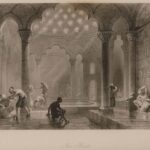Quote:
He is beautiful, flirtatious, attractive, polite, amiable and has the breast of a nightingale. His hair is like a hyacinth (red gemstone), his dimple a rose, his look like the hangman’s, his colour that of boxwood, his larynx like steel, his behind a crystal bowl, his navel a source of light, his calves like silver pillars, his feet, silver bars, his forehead curls like silk fringes.
Source:
Quoted by Sema Nilgün Erdoğan (1998, German): Sexuelles Leben bei den Osmanen. Istanbul: Dönence.
Author Bio:
The text “Yemenici Bali” (Bali the shoemaker's boy) comes from the book Dellakname-i Dilküsa (The Book on Bath Servants) from the 17th century, made famous in more recent times by the journalist Murat Bardakçı. "It is one of the rare erotic texts by the Ottomans that has been passed down to our time" (Erdoğan 1998). 1680 is an approximate date.
Context:
 Sexual contact between men was just as much a part of the Ottoman Empire as men’s poetry and fantasies about young men. Young boys, who often conformed to specific ideals of beauty, were not viewed as living male beings, but as a kind of imperfect man or woman. For many Ottomans, sexual contact with them was part of gaining experience before marrying a woman. As a man, having a relationship with a woman meant a stable life marked by family planning, loyalty, and purely conjugal sex with one’s wife. In his book Desiring Arabs (2008), Joseph Massad also speaks of Western sexual models that were imposed. He compiles historical Arabic writings on sexual desire and conservative responses to them. There is also ample evidence of homosexual relationships from ancient Greece, especially between men in Sparta and, between women, on the island of Lesbos.
Sexual contact between men was just as much a part of the Ottoman Empire as men’s poetry and fantasies about young men. Young boys, who often conformed to specific ideals of beauty, were not viewed as living male beings, but as a kind of imperfect man or woman. For many Ottomans, sexual contact with them was part of gaining experience before marrying a woman. As a man, having a relationship with a woman meant a stable life marked by family planning, loyalty, and purely conjugal sex with one’s wife. In his book Desiring Arabs (2008), Joseph Massad also speaks of Western sexual models that were imposed. He compiles historical Arabic writings on sexual desire and conservative responses to them. There is also ample evidence of homosexual relationships from ancient Greece, especially between men in Sparta and, between women, on the island of Lesbos.Further Reading:
*Arabmediasociety.com, 21.01.2009: Book Review Desiring Arabs.
Year:
1680